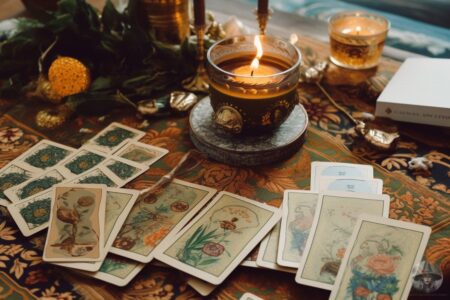Welcome to the Magical World of Tarot!
Welcome, dear beginners, to the mesmerizing world of tarot. This is an enchanting realm where self-discovery meets a profound connection with the universe. Think of tarot reading as a warm, inviting conversation with your higher self, a dialogue delicately woven with mystic symbols and deep-seated messages. While the cards themselves may hold an air of magic, remember that the true enchantment lies within you - in your own intuition. As you stand at the threshold of this extraordinary journey, Tarot for Beginners, always remember to trust in your inner voice. Let it be your compass, guiding you to translate the whispers of the tarot into personal insights and wisdom. Welcome aboard this magical ride and enjoy every moment of discovery it has to offer.
Setting the Stage for Your Tarot Journey
Your tarot reading journey begins with setting a sacred space, a sanctuary that resonates with your spirit. It could be as simple as arranging a cherished blanket, lighting a few candles, or surrounding yourself with your favorite crystals. This ritual is like inviting the energy of the universe to join you, strengthening the bond between you and your cards.
Connecting with Your Cards
With your sanctuary set and your cards ready, take a deep breath, hold your cards close, and tune into your energy. Embrace the feelings and thoughts surfacing within you, and let them guide your question to the cards. Whether it's a query about life's current lessons or your next significant step, ensure it comes from a place of sincere curiosity.
Understanding Your Tarot Deck
Your tarot deck, comprising 78 vibrant cards, is divided into two sections: The Major Arcana and the Minor Arcana. The Major Arcana's 22 cards symbolize significant life events and spiritual milestones, while the Minor Arcana's 56 cards mirror our daily feelings, thoughts, and experiences. Each card, whether from the Major or Minor Arcana, is an essential thread in the vibrant tapestry of your life's story.
Unveiling the Power of Numbers in Tarot
Each card carries a unique energy, thanks to the world of numerology. From the Aces (ones) symbolizing beginnings to the tens representing completion, each number offers a new layer of insight, further enriching your reading.
Creating Your Tarot Spreads
A tarot spread refers to the pattern in which you lay out your cards. The spread can be as simple or as complex as you choose, depending on the depth of insight you seek. Whether it's the three-card Past-Present-Future, the seven-card Horseshoe, or the ten-card Celtic Cross, remember to let your intuition guide your choice.
The World of Tarot: A Mirror to Your Inner Self
Ultimately, the world of tarot is a mirror reflecting your inner world, offering guidance, clarity, and empowerment. It doesn't predict your future but helps you make conscious decisions based on a deeper understanding of your present circumstances. So, breathe in, shuffle your cards, and step into this magical labyrinth of symbolic wisdom. Trust in the magic within you, and enjoy the mesmerizing dance with the divine!
Diving Deeper into Tarot Spreads
Tarot spreads add structure and depth to your reading, providing specific context to each card. From the popular 'Past-Present-Future' spread to the 'Mind-Body-Spirit', 'Situation-Obstacle-Advice', or 'You-Your Path-Your Potential' spreads, each offers unique insights and perspectives. The beauty of tarot spreads is their adaptability. You can create your own spread, setting an intention for each card position, and letting your intuition guide you. Whether it's an open-ended query like, "What message wishes to come through for me today?" or a more focused question, trust in your intuition to lead the way.
Interpreting the Threads of Your Tarot Story
Once your spread is laid out, it's time to interpret the cards. Each tarot card is a miniature universe, its unique symbols, elemental energies, and numerology adding depth and meaning to your reading.
In the Minor Arcana, the four suits represent the classic elements of Earth, Air, Fire, and Water. Cups, associated with Water, delve into the realm of emotions, creativity, and relationships. Pentacles, symbolizing Earth, speak of material wealth, career paths, and tangible manifestations. Swords, akin to Air, shed light on thoughts, communication, and challenges. Lastly, Wands, imbued with Fire, ignite our spiritual endeavors with inspiration, energy, and enthusiasm.
In addition to these elemental symbols, each card's numerical value enriches its meaning. From '1', signifying new beginnings, to '10', indicating the completion of a cycle, numerology adds a new dimension to your tarot reading.
With more complex narratives, the Major Arcana also reverberate with numerological energies. For instance, the number '13' symbolizes chaos, but when broken down into '4' (1+3), it signifies foundation and stability, embodying the transformative nature of tarot.
Unveiling the Symbols in Tarot
Each tarot card is a canvas of symbols. From jagged mountains hinting at looming challenges to tempestuous seas mirroring emotional turbulence, these symbols add another layer of depth to your understanding. As you explore each card, let these symbols tell their stories, guiding you on your path to self-discovery.
In conclusion, the world of tarot is a magical labyrinth full of symbolic wisdom, inviting you to delve deeper into your own intuition. So, embrace this extraordinary journey with open arms and an open heart. Immerse yourself in the enchantment, and watch as the mysteries of the tarot come alive. Enjoy every step of this divine dance with the universe!


